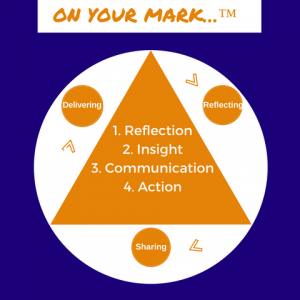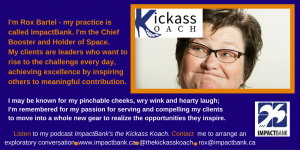Positional and personal leadership is grounded in presence. Your presence is generated out of your internal state of readiness. You ready?!
You may think all these new faces that report up into you are just waiting to see what you will say to inspire and lead them. In fact, they are doing much more than listening to your words. You are under a microscope – frankly, it’s more invasive than that. Your every move is being filtered through every experience they’ve had with past bosses and every single assumption and belief, limiting or not, they’ve acquired over a lifetime. It’s not my intention to overwhelm you; I do want you to understand why taking poorly considered or ill-conceived action just to prove your positional power is unwise. Losing respect from people and possibly starting or stirring up unnecessary fires is just going to make your experience more difficult. You must focus on cultivating trust.
If you have been following along in the stages I’ve been describing, we are at Stage 3 of my On Your Mark Model. It’s the place of readying yourself for action – part of it is communicating deeply. Most transitioning leaders, in my experience, decide, to communicate deeply means sharing about themselves. “Less is More” will never be more true than right now. “More Show, Less Tell” is also a great motto for these early months. Show your people how you listen and appreciate and consider and engage. It is powerful and your presence when exhibited in this way will send a powerful message and engender trust.
First, we’ll review, before jumping further into the lessons of Episode 097.
In Episode 095 we discussed the importance of stepping back and reflecting, both on what you want to accomplish in this new role and on what you are observing in the data, in the actions and outcomes of the team. This is the time to seek input from trusted advisers AND, most importantly reflect out loud with a good sounding board – this is a great time to engage a coach.
In Episode 096 we discussed the importance of seeing around the corner. You need to dig into all the data, ask a boat-load of questions and soak it all up. You have likely, coming out of stage one, started to form some opinions and conclusions. If you engaged a coach, she will help you avoid getting too settled into those by challenging you to look and listen more deeply at other perspectives so you don’t miss important elements of the picture. You’ve been spending a lot of time: observing, engaging your curiosity and openness, spending time in deep reflection on your own and with others.
AND you’ve spent time examining patterns and getting curious about them. Your picture of the current state of your team or organization is beginning to come into focus and you can start to see around a few corners with both anticipation and curiosity – you are developing the context to help you interpret that which will greet you on the other side of the curve.
You now have a foundation on which you can start to build your readiness for action – this is the stage of planning. It requires the most openness and creativity and communication skills of all the stages. This is when you most need help to process and tailor your thinking and intentions. One of my clients, after moving through this stage, suggested one day that I write a manual or a book to help others through this stage. I remember laughing and saying I was working on it but that it required so much tailoring for the individual that it was proving a challenge.
This made me think of a story David Rock tells in his book, Quiet Leadership about how he and his wife bought identical lap tops but when he tried to use her machine one day when his was unavailable, he was frustrated by the effort required as he struggled uncomfortably to navigate. I sometimes help my 87-year-old mother as she manages something new on her Mac-book and experience something similar. Frankly we all have experienced exactly this, many times in our lives; the closer we are to someone the more annoying it is because it doesn’t make sense to us. Our brains and thought patterns really do organize themselves differently; mine and David Rock’s experience demonstrates why as leaders we have to listen intently and test our thinking and assumptions thoroughly as part of the readiness stage. It also speaks to the benefits a coach at this stage can bring to help you sharpen your thinking and noticing skills.
So, while I co-create this stage with my clients to ensure it is tailored to you – your strengths, your goals, and the specific observations and generated insights – in my experience this phase may include: checking out the depth and meaning within the insights; further data reviews looking for patterns and supporting evidence for the action plan; focus groups or 1:1 conversations with stakeholders where you test out your theories NOT by advocating for them but rather to learn from the response; developing a communications strategy or in the event you are ready, an implementation plan. Whatever your Readiness approach entails, you will emerge with confidence and clarity on the ACTIONS to be taken.
You may find it helpful to go back to episode 092 when I shared some of what Rhoda (who we’ve referenced from episodes 091 through 096); you may find, if you haven’t yet, that listening to back episodes will put today’s post in context.
In Episode 097 I offer a small tip: build an implementation strategy in consultation and ensure the communication strategy is well thought through and SCARF’d. If you are new to my podcast you may not have heard episodes from 2015; you’ll find “Leadership on the Brain from November and December 2015 (episodes 20-25 start HERE).
From my own personal experience and observing clients, it is critical you not move forward aggressively coming out of this stage. You were promoted or hired, in part, because of your action orientation and it will serve you well, HOWEVER, if you, like many leaders, anchor yourself in positional power over people you will damage relationships before they are formed. Instead you want to build trust and you can start by surfacing ideas, insights, and problems by doing what is often counter-intuitive to many impressive leaders: Deep Collective Learning. What if you can be a leader who exercises “power-to/with” first and, only as a last resort, “power-over”.
Next time: It’s Go-Time – how not to be the bull in the china shop.



